|
March 6, 2012 12:16:16
Posted By DelvecchioRC
|
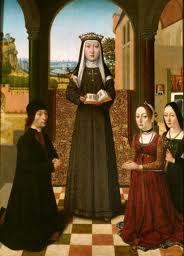
St. Catherine of Bologna, Virgin (Patroness of Artists) Feast - March 9th
Despite the opportunity to live a noble life at court, St. Catherine eagerly responded to her call to lead the religious life. Her piety, charity, and kindness attracted many to follow her along the road to perfection. The beauty of her life and death encourages us to resolve to live in perfect charity as a Lenten goal.
Born in 1413, Catherine de Vigri was the daughter of a diplomatic agent of the Marquis of Ferrara. At the age of eleven, she was appointed maid of honor to the daughter of the Marquis and shared her training and education. When the daughter eventually married, she wanted Catherine to remain in her service, but Catherine left the court and became a Franciscan Tertiary at the age of fourteen.
Catherine had determined to live a life of perfection, and was admired by her companions for her holiness. Eventually her Community became part of the Poor Clares. She soon began to experience visions of Christ and Satan, and wrote of her experiences, one of which occurred one Christmas. Through her efforts with Pope Nicholas V, the Poor Clare convent at Ferrara erected an enclosure, and Catherine was appointed Superioress. The reputation of the Community for its holiness and austerity became widespread. She then was appointed Superioress of a new convent in Bologna.
In Lent of 1463, Catherine became seriously ill, and she died on March 9th. Buried without a coffin, her body was exhumed eighteen days later because of cures attributed to her and also because of the sweet scent coming from her grave. Her body was found to be incorrupt and remains so today in the Church of the Poor Clare convent in Bologna. She was canonized in 1712.
|
|
February 28, 2012 08:06:51
Posted By DelvecchioRC
|
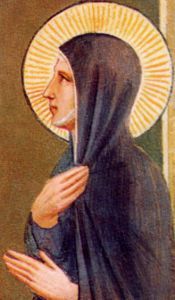
Blessed Villana was the daughter of Andrew de'Botti, a Florentine merchant, and was born in 1332. When she was thirteen she ran away from home to enter a convent but her attempts were unsuccessful and she was forced to return. To prevent any repetition of her flight, her father shortly afterwards gave her in marriage to Rosso di Piero. After her marriage she appeared completely changed; she gave herself up to pleasure and dissipation and lived a wholly idle and worldly life. One day, as she was about to start for an entertainment clad in a gorgeous dress adorned with pearls and precious stones, she looked at herself in a mirror. To her dismay, the reflection that met her eyes was that of a hideous demon. A second and a third mirror showed the same ugly form. Thoroughly alarmed and recognizing in the reflection the image of herself sin-stained soul, she tore off her fine attire and, clad in the simplest clothes she could find, she betook herself weeping to the Dominican Fathers at Santa Maria Novella to make a full confession and to ask absolution and help. This proved the turning point of her life, and she never again fell away. Before long Villana was admitted to the Third Order of St. Dominic, and after this she advanced rapidly in the spiritual life. Fulfilling all her duties as a married woman, she spent all her available time in prayer and reading. She particularly loved to read St. Paul's Epistles and the lives of the saints. At one time, in a self-abasement and in her love for the poor, she would have gone begging for them from door to door had not her husband and parents interposed. So completely did she give herself up to God that she was often rapt in ecstacy, particularly during Mass or at spiritual conferences; but she had to pass through a period of persecution when she was cruelly calumniated and her honor was assailed. Her soul was also purified by strong pains and by great bodily weakness. However, she passed unscathed through all these trials and was rewarded by wonderful visions and olloquies with our Lady and other saints. Occasionally the room in which she dwelt was filled with supernatural light, and she was also endowed with the gift of prophecy. As she lay on her deathbed, she asked that the Passion should be read to her, and at the words "He bowed His head and gave up the ghost", she crossed her hands on her breast and passed away. Her body was taken to Santa Maria Novella, where it became such an object of veneration that for over a month it was impossible to proceed with the funeral. People struggled to obtain shreds of her clothing, and she was honored as a saint from the day of her death. Her bereaved husband use to say that, when he felt discouraged and depressed, he found strength by visiting the room in which his beloved wife had died. Blessed Villana's cultus was confirmed in 1824. Her feast day is February 28th.
|
|
November 1, 2011 07:46:38
Posted By DelvecchioRC
|
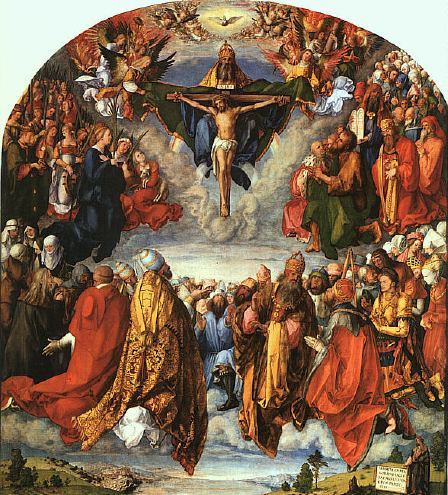
In Catholicism, All Saints' Day is a Holy Day of Obligation in many countries including the United States, meaning going to Mass on the date is required unless one has a good reason to be excused from that obligation, such as illness.
All Saints' Day (in the Roman Catholic Church officially the Solemnity of All Saints and also called All Hallows or Hallowmas), often shortened to All Saints, is a solemnity celebrated on 1 November by parts of Western Christianity, and on the first Sunday after Pentecost in Eastern Christianity, in honour of all the saints, known and unknown.
In Western Christian theology, the day commemorates all those who have attained the beatific vision in Heaven. It is a national holiday in many historically Catholic countries. In the Roman Catholic Church and many Anglican churches, the next day, All Souls' Day, specifically commemorates the departed faithful who have not yet been purified and reached heaven. Christians celebrate All Saints' Day and All Souls' Day in the fundamental belief that there is a prayerful spiritual bond between those in the state of grace who have burned and are either being purified in purgatory or are in heaven (the 'Church Suffering' and the 'church triumphant', respectively), and the 'church militant' who are the living.
Mass tonight at Sacred Hearts-St. Stephen Church is at 7pm for All Saints
|
|
August 15, 2011 01:14:22
Posted By DelvecchioRC
|
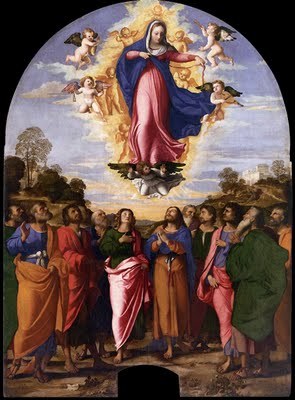
According to the belief of Christians of the Roman Catholic Church, the Eastern Catholic Churches, Eastern Orthodoxy, Oriental Orthodoxy, and parts of the Anglican Communion and Continuing Anglicanism, the Assumption of Mary was the bodily taking up of the Virgin Mary into Heaven at the end of her life. The Roman Catholic Church teaches as dogma that the Virgin Mary "having completed the course of her earthly life, was assumed body and soul into heavenly glory." This doctrine was dogmatically and infallibly defined by Pope Pius XII on November 1, 1950, in his Apostolic Constitution Munificentissimus Deus. In this dogmatic statement, the phrase "having completed the course of her earthly life," leaves open the question of whether the Virgin Mary died before her assumption or whether she was assumed before death; both possibilities are allowed. Mary's assumption is said to have been a divine gift to her as the 'Mother of God'. This belief is known as the Dormition of the Theotokos by the Eastern and Oriental Orthodox Churches. In the churches which observe it, the Assumption is a major feast day, commonly celebrated on August 15. In many countries it is a Catholic Holy Day of Obligation.
|
|
August 15, 2011 01:14:22
Posted By DelvecchioRC
|
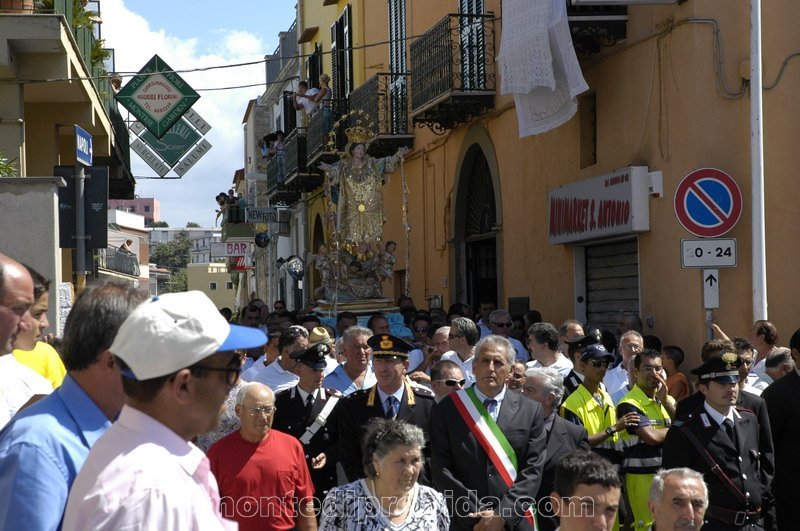
The statue of Our Lady of the Assumption at Sacred Hearts-St. Stephen Church in Brooklyn was brought to America by the people of Monte di Procida, Italy. The Story of their devotion is as follows:
The Assunta celebration is one of the most profound but less known traditions in the phlegreian land. But how is it born the devotion for the Madonna Assunta (the Virgin of Assumption)? What the roots of a tradition which mixes, as so often happens, sacred and profane, popular beliefs and religious precepts?A fascinating story, which mirrors the history itself of the birth and the growth of the city from the first nomad groups of peasants coming from the isle of Procida, who came to establish on the cliffs straight down to the sea of the Monte, in seventeenth century, to the present days. And in more than four centuries of history, the Assunta never stopped being worshipped. When the first colonists coming from Procida started to settle down in the lands owned by cardinal Filomarino, to work in the fields, vineyards and vegetables were verdant through the whole headland and the Virgin’s patronage was yet invoked as to she granted a huge harvest. Then the inhabitants of Monte bounded for the sea routes, and to the Virgin they made vows at every crossing, as she watched over the sea and the destiny of those who sailed challenging the waves for fishing or commerce. The navy of Monte di Procida became, soon, one of the best in the “land of fire” and the devotion even deeper than before. To participate to the celebration, over all for those who were far away, represented a most important event: to miss it was considered more serious than not being home at Christmas or Easter...Phrases that sailors kept repeating to one another: in every point of the world they were, from the ship’s boy to the captain, they followed by heart the procession, to which they could not be present in person; with eyes bright of emotion they could hardly hide, they accompanied the various moments of the ceremony with the sound of the siren. To sum up, even in the back of beyond, they followed the Virgin, they too were “Appriess’ a Maronna” united in spirit to whom, remained in the city to wait for them, was following the statue, eventually praying for them. And when so many people were obliged to emigrate “a’ Maronn” followed them. And they rewarded Her with a devotion profound and full of nostalgia for the native land so far, of which the Assunta represented an unforgettable “piece”, to the point that they organized a “Festa d’a Madonna” even in the States, with the same statue, a perfect copy of the Assunta by Verzella kept in the parish church in the central square, if it was completely impossible to come home for the 15th of August to follow the procession, to be grateful for the fortunes granted and repay the vows fulfilled.
|
|
|
|




